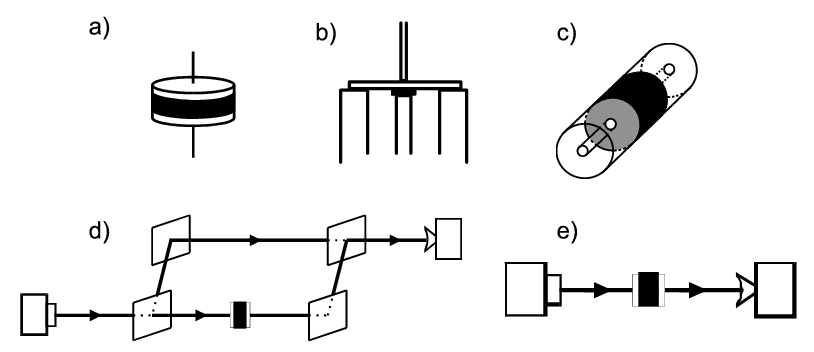DIELECTRIC SPECTROSCOPY
1. Broad-Band Dielectric Spectroscopy
In the Experimental Physics V group at the University of Augsburg, we were able to perform dielectric studies utilizing a large variety of techniques which nearly continuously cover an exceptionally broad frequency range from 3 µHz up to 360 THz. Different cooling and heating devices allowed for measurements from 1.2 to 1000 K. Moreover, measurements in external magnetic field up to 14 T were possible.
-
Low-Frequency Dielectric Spectroscopy (< 10 MHz)
In this typical frequency region of "classical" dielectric spectroscopy,
the samples are prepared as parallel-plate capacitors ((a) in the figure below). Using a variety of
setups, the complex dielectric constant or the complex conductivity can be
determined by measuring the frequency- (or time-) dependent properties and
calculating the absolute values from the geometrical dimensions of the sample. Various autobalance bridges and frequency-response analyzers were avalailable in our group for measurements in this range.
-
High-Frequency Dielectric Spectroscopy (1 MHz < ν < 40 GHz)
In this radio and microwave region, standard dielectric techniques employing
BNC-cable connections no longer work and specially designed rigid coaxial
lines are used. Especially in the GHz region, some special "know-how" is
necessary to obtain reliable results.
In the coaxial reflection technique (up to 3 GHz) the sample is mounted at the end of a coaxial line, thereby bridging inner and outer conductor (e.g., (b) in the figure below).
A special variant is the open-end coaxial reflection method where the end of a coaxial line is completely immersed into the liquid under investigation. This method works up to about 40 GHz.
In the coaxial transmission technique the sample completely fills the space between inner and outer conductor of a coaxial line ((c) in the figure below), whose transmission properties are determined. This method was especially adapted in our group to also enable the investigation of low-loss samples. For frequencies up to 40 GHz, network analyzers were employed.
-
Submillimeter-Wave and THz Spectroscopy (40 GHz < ν < 4 THz)
In this frequency region, we used quasi-optic methods employing a Mach-Zehnder setup ((d) in the figure below) and backward wave oscillators as radiation source. Moreover, pulsed THz-spectroscopy enables fast measurements in this frequency range by Fourier-transform analysis of short pulses of coherent broadband THz radiation transmitting the sample.
-
Fourier-Transform Infrared Spectroscopy (> 1 THz)
Here we used various commercial Fourier-transform infrared spectrometers ((e) in the figure below).

|
Schematic plots of typical sample geometries used for the different measurement techniques
(the sample material is indicated by the filled black regions): (a) parallel-plate capacitor
for low-frequency measurements; (b) coaxial reflection setup where the sample forms the end
of the inner conductor (also other configurations can be used); (c) coaxial transmission line,
filled with sample material; (d) scheme of Mach-Zehnder spectrometer used in the submillimeter
wavelength range; (e) transmission measurements in the Fourier transform infrared spectrometer.
[from: P. Lunkenheimer et al., in "Structural Glasses and Supercooled Liquids:
Theory, Experiment, and Applications", edited by P.G. Wolynes and V. Lubchenko (Wiley, Hoboken,
2012)].
|
For more details on linear dielectric techniques employed in our group see, e.g.:
-
Radio-frequency dielectric measurements at temperatures from 10 to 450 K
R. Böhmer, M. Maglione, P. Lunkenheimer, and A. Loidl
J. Appl. Phys. 65, 901 (1989).
-
Wide range dielectric spectroscopy on glass-forming materials: An experimental overview
U. Schneider, P. Lunkenheimer, A. Pimenov, R. Brand, and A. Loidl
Ferroelectrics 249, 89 (2001).
-
Dielectric spectroscopy of glassy dynamics
P. Lunkenheimer, M. Köhler, S. Kastner, and A. Loidl
in "Structural Glasses and Supercooled Liquids:
Theory, Experiment, and Applications", edited by P.G. Wolynes and V. Lubchenko (Wiley, Hoboken, 2012).
2. Nonlinear Dielectric Measurements
In broadband dielectric spectroscopy, usually relatively low voltages of up to several volts are applied to the samples. Thus, these measurements are performed in the linear regime of the P(E) (polarization vs. field) curve. In addition, a variety of field-dependent and pyroelectric measurements can be performed. These methods can be used to investigate, e.g., P(E) hysteresis loops or spontaneous polarization in ferroelectrics or multiferroics. Also the non-linear properties of
supercooled liquids
can be investigated, which helps understanding the dynamic processes at the glass transition.
Dielectric spectra could be collected applying maximum ac voltages of 4000 V (peak to peak) corresponding to electrical fields of up to several 100 kV/cm, depending on sample thickness and electric strength of the material. In this way, in addition to the conventional dielectric susceptibility at high fields, its higher-harmonic components can also be detected.
In addition, polarization vs. field hysteresis-curves could be measured, also allowing for a determination of the high-field dielectric permittivity, including its higher-harmonic components, at voltages up to 10 kV. Pyrocurrent measurements allow for the determination of field-cooled/zero-field-cooled polarizations.

Three capacitor setups as used by our group for nonlinear dielectric measurements of liquids.
[from: P. Lunkenheimer, M. Michl, Th. Bauer, and A. Loidl,
Eur. Phys. J. Special Topics 226, 3157 (2017).]
Devices:
- Novocontrol "Alpha-A" frequency-response analyzer, combined with "HVB300" or "HVB4000" high-voltage test interfaces
- Aixacct TF2000 P(E) analyzer
- Keithley 6517 electrometer
For some details on nonlinear dielectric techniques employed in our group, see:
Homepage P. Lunkenheimer

